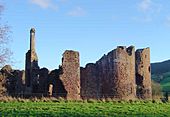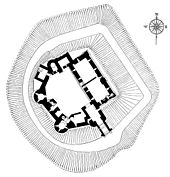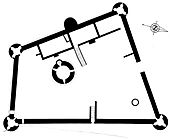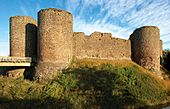Three Castles facts for kids
The Three Castles were a group of three important medieval castles in Monmouthshire, Wales. These castles are Grosmont, Skenfrith, and White Castle. They were built by the Normans after they conquered England in 1066. Their main job was to protect a key route from Wales to Hereford.
At first, these castles were simple earth mounds with wooden defenses. In 1135, a big Welsh uprising happened. In response, King Stephen brought the castles together. This created a special area called a "lordship" (a land controlled by a lord). The castles continued to defend the area for many centuries.
Most of what we see of the castles today was built in the 13th century. In 1201, King John gave the castles to a powerful official named Hubert de Burgh. Over the next few decades, the castles changed hands many times. Hubert completely rebuilt Skenfrith Castle and made big changes to Grosmont. White Castle was likely rebuilt in the 1250s and 1260s.
In 1267, the Three Castles were given to Edmund, the Earl of Lancaster. They stayed with the Lancaster family until 1825. When King Edward I conquered Wales, the castles became less important for defense. By the 16th century, they were no longer used and fell into ruin. Today, the Welsh heritage group Cadw looks after them. You can even walk between them on a path called the Three Castles Walk.
Contents
History of the Castles
Early Days: 11th and 12th Centuries
The castles that became known as the "Three Castles" were built after the Normans invaded England in 1066. Soon after, the Normans moved into the areas near Wales, known as the Welsh Marches. William the Conqueror made William fitz Osbern the Earl of Hereford. Earl William took over more land, including Monmouth and Chepstow.
The Normans used castles a lot to control the Welsh people. They also built new towns and showed their power over the land. Grosmont, Skenfrith, and White Castle were all built around this time. They were located in the Monnow valley to protect the route to Hereford. The first castles were made of earth and wood.
After William's son rebelled in 1075, the land around the castles was split up. But in 1135, a major Welsh revolt happened. King Stephen then brought the castles back under the control of the King. This created the "Three Castles" lordship.
Fighting with the Welsh continued. In the 1170s, some powerful families attacked their Welsh rivals. This led to a Welsh attack on nearby Abergavenny Castle in 1182. Because of this, the King prepared the castles for battle. Parts of Skenfrith and White Castle were rebuilt with stone.
Changing Hands: 13th to 17th Centuries
In 1201, King John gave the Three Castles to Hubert de Burgh. Hubert was a royal official who became very powerful. He started to improve his new castles, beginning with Grosmont. But he was captured while fighting in France. While he was away, King John took the castles back. He gave them to William de Braose, who was Hubert's enemy.
The king later fell out with William and took his lands in 1207. But William's son took the castles back during a war. Once Hubert was free, he became very powerful again. He finally got the Three Castles back in 1219, when King Henry III was on the throne. During Hubert's time, Skenfrith Castle was completely rebuilt. The old castle was flattened, and a new stone castle was built with round towers and a central circular keep.
Hubert lost power in 1232, and the castles were taken from him again. In 1233, King Henry led an army into Wales. They camped outside Grosmont Castle. An enemy leader attacked their camp at night. The king's army had to run away. Hubert got the castles back briefly in 1234. But he fell out with King Henry III again in 1239, and the castles were taken back.
In 1254, the castles were given to King Henry's oldest son, Prince Edward. The castles were made ready for battle in 1262 when the Welsh leader Llywelyn ap Gruffudd attacked Abergavenny. Skenfrith Castle was ordered to be defended "by every man, and at whatever cost." Luckily, the attack did not happen.
In 1267, Edmund, the Earl of Lancaster, was given the castles. For many centuries, they were owned by the Lancaster family.
When King Edward I conquered Wales in 1282, the castles were no longer as important for war. However, they were still used to manage the land. The last time the castles were involved in a fight was during the revolt of Owain Glyndŵr in the early 1400s. Grosmont was attacked in 1405 but was saved by an English force. By 1538, the castles were no longer used and were falling apart. A description from 1613 said they were "ruined and decayed."
Modern Times: 18th to 21st Centuries
In 1825, the three castles were sold to Henry Somerset, the Duke of Beaufort. In 1902, the land was split up and sold to different private owners. They did some work to protect the castles. In the early 20th century, the castles were put into the care of the state. A lot of repair work was done.
Today, the three castles are looked after by the Welsh heritage group Cadw. They are protected under UK law as important historical buildings. A 30-kilometer (about 18.6 miles) long walking path called the Three Castles Walk connects the castles.
The Castles
| Name | Image | Plan | Location | Description |
|---|---|---|---|---|
| Grosmont Castle |  |
 |
Grosmont 51°54′55″N 2°51′57″W / 51.915278°N 2.865833°W |
Grosmont Castle mostly dates from the 13th century. It had an inner area and an outer area. The inner area is a stone castle with a gatehouse, two round towers, a hall, and a north building. It was protected by a ditch. |
| Skenfrith Castle |  |
 |
Skenfrith 51°52′42″N 2°47′25″W / 51.8784°N 2.7902°W |
Skenfrith Castle was built in the early 13th century after the older castle was taken down. It is shaped like a polygon and was protected by a water-filled moat. The main wall still stands, with round towers at each corner. A three-story round keep is in the middle of the castle. |
| White Castle |  |
 |
Llantilio Crossenny 51°50′43″N 2°54′10″W / 51.8454°N 2.9029°W |
White Castle mainly dates from the 13th century. It has a central inner area, a crescent-shaped part to the south, and an outer area to the north. Buildings like the hall, living quarters, and kitchen were inside the inner area. Historians consider it a "masterpiece of military engineering." |
Images for kids



